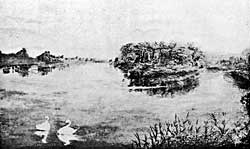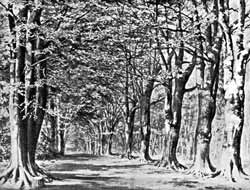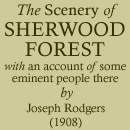< Previous | Contents | Next >
THORESBY
"Lord, who would live turmoiled in the court,
And may enjoy such quiet walks as these?"Shakespeare.

Thoresby Lake.
ONE of the most beautiful of the many fine parks that adorn this kingdom is undoubtedly Thoresby. It is inseparably a part of the old forest; numbers of the trees now standing were here before Robert de Pierpont, the ancestor of the present noble owner of the estate, came to England in the train of Duke William, and in any account of Sherwood, Thoresby must, of necessity, have a place.
Near the classic bridge in the park, at a short distance from Budby, may be found one of the most charming scenes in the locality. From this point may be seen Kingston Island in the middle of the lake, and on rising ground further away is Thoresby House, with the graceful spire of Perlethorpe Church in the distance. Here and there may be recognised, by their rugged contours, some of Sherwood's ancient oaks, while the white blossoming thorn flourishes everywhere, and is perhaps, when its perfume scents the air, the most favoured of all trees. Never is there more pleasure in looking on the old oaks than in spring, when they give tokens of renewed vigour. Then the Scotch firs, with their sombre foliage, and stems glowing of a bright orange in the sunlight, show to advantage the fresh bright green of the beech; and certainly at no other time does the great avenue of Spanish chestnuts look so lovely. The birds by their songs are known to be most happy in spring, and near this lake they seem to sing their sweetest. Swans and other aquatic birds abound. We are told by Sherland of some herons making their nests on these great trees; but alas! this proved no paradise to them, for in some seasons their eggs were destroyed by the carrion crow, and eventually the herons were all shot by the keepers. The osprey, though seldom seen in this part of the country, took up its abode near the lake for a few weeks in the summer of 1855. It was frightened away by the keepers. White, in The Natural History of Selborne, speaks of the bird as being a rarity in that neighbourhood.
From the early part of the eighteenth century a number of large models of sea-going vessels were on this lake. In 1795, Throsby names "this fine sheet of water, bearing vessels, of no great burthen, richly ornamental," and he adds, "their little streamers wafted by the wind have a pretty effect." The last of these vessels, built of cedar, was broken up about fifty years ago; the captain of it, an old sailor, lived and died at Castle William, a picturesque, ivy-covered house on the adjacent hill.
Architects of the present day, perhaps, succeed in erecting bridges that are more convenient for use than the fine specimen of eighteenth-century work in Thoresby Park; and, in populous places, utility, no doubt, should be one of the first considerations; but every one will perceive how much more handsome is the general design, as well as the detail of this bridge (with the crown of the arch slightly higher than the level of the road, and the lines of its balusters gracefully carved) than many of more recent erection.
On each side the pathway from the lake of Chameleon Lodge are a number of groups of noble beeches and Scotch firs; some of the finest in the park. Though not so grand in their effect as before the winter of 1894, when two of the most handsome beeches were blown down. There is a look of contentment in the dwelling at the head of this road, sheltered from cold winds by lovely evergreen trees of phenomenal growth; while in the pleasure garden in front of the house is a mass of lovely sweet scented flowers, and from the windows an uninterrupted view of beautiful scenery where the occupant may wander at his pleasure. The dweller in a town may well say "here is everything needful to a happy life."
From these more elevated parts of the park extensive views are obtained of the finely-wooded landscape. The river Meden may be traced from its entrance to the lake, shining like a thread of silver, and again as it emerges near Thoresby House on its course towards Perlethorpe; joining the Maun a little lower down. Among the thorns, the chestnuts, and the old forest oaks, are many groups of beeches; Scotch firs crowning the uplands, and occasionally a company of fine, vigorous yews, but not more than two or three centuries old, and wanting in the picturesque beauty that age alone can give.
An agreeable diversity of colour is given to the scenery by the numerous herds of deer; often a solitary stag may be seen half buried in the bracken, apparently absorbed in meditation. He seems to be the poet among animals, and as he walks away his every movement is full of grace.
It is pleasant to be reminded by the name of the wood at the northern extremity of the park, of Evelyn, the famous diarist. Trees in this wood, protected from rough weather by proximity to each other, seem to lead an ideal life. How rapid and how perfect has been the growth of these pines! And the Wellingtonia, though it cannot be said to be a picturesque tree, promises to rival the height it attains in its native land.

Beech Avenue, Thoresby Park.
Gilbert White, in his Selborne, asserts that the beech is "the most lovely of forest trees, whether we consider its smooth rind or bark, its glossy foliage, or graceful pendulous boughs." Among forest trees there is no doubt that it occupies a high position, but if judged by its graceful growth it has a formidable rival in the birch, with its silvery bark, its slender branches and delicate leafage. Nor should the elm with its splendid masses of foliage be forgotten. Nor the stately Scotch fir, its sombre leaves whispering to every passing wind. Is there not also a wondrous amount of feathery grace and lovely colour in the spring foliage and blossom of the larch? May not the rugged grandeur of the oak claim one's admiration equally with the grace of the beech? It is difficult to give a preference to one, where each has a special beauty of its own. But there does seem a probability that an avenue of beeches, such as this, first gave the old-time architect his inspiration when designing the "pointed aisle and shafted stalk" of the great religious houses; so close is the resemblance between the bole of this tree and the column of the cathedral aisle, and so great the similarity of the curving of the upper branches and the groining of the roof.1
There are few finer specimens of the old oaks of Sherwood than those adjoining the carriage drive in the park, near the Edwinstowe gate. Their trunks, massive and grand, and their roots spreading in all directions, give evidence of enormous strength ; while their foliage seems to be as vigorous and plentiful as in their early days.
Standing near the head of the Chestnut Avenue, which reaches from this point towards the river, might be seen, about fifty years ago, the Thoresby House which preceded the present one. In 1873 it was taken down, the more magnificent mansion being then nearly completed. It was a plain square building, without any pretence to architectural adornment, replacing the one destroyed by fire in 1745, which had itself replaced an earlier one of Elizabethan character not very long before that date. The situation being near the river, must have been cold and damp in the winter. A distinguished member of this family, writing in 1754, says: "I imagine the Duke of Kingston is now building. I was told he intended it on the same ground where the last house stood, which I think an ill fancy, being the lowest part of the park, and he might choose others with a prospect more agreeable, which is, in my opinion, the first thing to be considered in a country seat."
Robert de Pierrepont, who was of French extraction, came first into England at the time of the Conquest, and from a general survey taken soon afterwards, appears to have then possessed the lordships of Henestede and Wretham, in Suffolk, which he held of the famous William, Earl Warren; one of the chief nobles who accompanied the victorious Norman duke. And, although none of the descendants of this Robert de Pierrepont received the honour of a peerage until the reign of King Charles, they were men of great note throughout succeeding times, both for the considerable lands they possessed in several counties, and also for services in the wars.
In the thirteenth century Sir Henry de Pierrepont married Annora, only daughter of Michael de Manvers, and sister and heiress to Lionel de Manvers, by whom he became possessed of several lordships in Nottinghamshire, and among them that of Holme, which now retains the name of Holme-Pierrepont.
Sir William Pierrepont, who was present at the battle of Stoke, near. Newark, in the reign of Henry the Seventh, was made a Knight Banneret in reward for his valour at the sieges of Therounne and Tournay in the time of Henry the Eighth. By his second wife, who was daughter of Sir Richard Empson, he was father of Sir George Pierrepont, who was created a knight of the carpet at the coronation of Edward VI.
Upon the dissolution of the monasteries by Henry the Eighth, Sir George Pierrepont became possessor of many manors.
Henry de Pierrepont, son of the last-named Sir George, married Frances, daughter of Sir William Cavendish and "Bess of Hardwick." The second son of this marriage, Robert de Pierrepont, was said by Thoroton to be not more distinguished for his fortune, which was ample, than for the endowment of his mind. He was educated at Oxford, and in 1601 represented Nottingham in Parliament. Charles the First, in the third year of his reign, raised him to the dignity of Lord Pierrepont of Holme-Pierrepont, in Nottinghamshire, Viscount Newark, and soon afterwards Earl of Kingston.
The Earl of Kingston was accidentally killed near Gainsborough on the 3Oth of July, 1643.2
Henry, first Marquis of Dorchester, eldest son of Robert Pierrepont, Earl of Kingston, was born in 1606. At an early age he sat in Parliament under the title of Viscount Newark. In 1642, when the King began to raise forces, Lord Newark rendered him considerable assistance. In the Life of Colonel Hutchinson an account is given of an attempt made at Nottingham by Lord Newark to seize the store of powder belonging to the county, for the King's use, which was frustrated by Colonel Hutchinson.3
After the death of his father he joined the King at Oxford, where, in regard for his faithful service, his Majesty conferred upon him the title of Marquess of Dorchester. While at Oxford, Dorchester earned great reputation with the soldiers by his opposition to the rest of the council in their determination to surrender Oxford.
In 1647 he surprised the Royalists by compounding for his estate. He had not fought in the King's army. His delinquency consisted solely in sitting in the Oxford Parliament. He was assessed to pay £7,447. Early in life Dorchester was greatly addicted to learning, seldom spending less than ten or twelve hours in the day at his books; and when the war was over he returned to his studies. For some time he lived at Worksop Manor, lent to him by the Earl of Arundel, two of his own houses having been ruined during the war. But after the death of the King he declared there was no living in the country, for every workman thought himself equal to the greatest peer; and a few months afterwards he removed to London. Sedentary habits and trouble of mind brought on illness, and this suggested to him the study of physic, to which he applied himself with great energy. To the study of medicine he added that of the law, and in 1651 was admitted to Gray's Inn.
The Royalists regarded his conduct as unbecoming to his order, and it was reported that by his prescriptions he had killed his daughter, his coachman, and five other patients.
< Previous | Contents | Next >
1 Charles Kingsley,
in his Biography, says on this subject: "I once scandalised a
man, who had been sentimentalising about Gothic aisles, by telling
him that all agreed that they were built
in imitation of the glades of forest trees, with branches interlacing
overhead. And that I liked God's work better than man's.
"In the cathedral we worship alone, and
the place is dumb, or speaks only to us, raising a semi-selfish emotion
; that is, having its beginning
and end in us. In the forest every branch and leaf, with the thousand
living things which cluster on them, all worship with us. ... They are
all witnesses of God, and every emotion of pleasure which they feel is
an act of praise to Him."
2 In the Life of Colonel Hutchinson, his
biographer, writing from a Commonwealth point of view, gives a different
estimate of the character
of this Earl. Mrs. Hutchinson says that at the commencement of the difference
between Charles I. and the Parliament, "The Earl of Kingston a few
months stood neuter, and would not declare himself of either party, and
being a man of great wealth and dependencies, many people hung in suspense
by his example; whereupon the gentlemen of Nottingham often spoke to his
son, to persuade his father to declare himself, but he told them he knew
his father's affections were firm to the Parliament, that he had encouraged
him to join with them, and promised him money to carry it on, and such
like things, which he continually assured them, till the Colonel's cold
behaviour, and some other passages, made them at length, those at least
who were firm to the cause, jealous both of the father and the son. Hereupon
when the danger grew imminent, and my lord lay out a brave prey to the
enemy, they sent Captain Lomax, one of the committee, to understand his
affections from himself, and to press him to declare for the Parliament,
in that so needful season. My lord professing himself to him rather desirous
for peace, and fully resolved not to act on either side,
made a serious imprecation on himself in these words: 'When,' said he,
' I take up arms with the King against the Parliament, or with the Parliament
against the King, let a cannon bullet divide me between them:' which God
was pleased to bring to pass a few months after; for he, going into Gainsborough,
and there taking up arms for the King, was surprised by my Lord Willoughby,
and after a handsome defence of himself, yielded, and was put prisoner
into a pinnace, and sent down the river to Hull, when my Lord Newcastle's
army marching along shore, shot at the pinnace, and being in danger, the
Earl of Kingston went upon the deck to show himself, and to prevail with
them to forbear shooting, but as soon as he appeared a cannon bullet flew
from the King's army and divided him in the middle, being then in the Parliament's
pinnace, who perished according to his own unhappy imprecation."
3 "Mr. Hutchinson being in Nottingham, and going to the mayor's to
have some news, he met with such as he expected not, for as soon as he
came in, the mayor's wife told him that the sheriff of the county was come
to fetch away the magazine that belonged to the train bands of the county,
which was left in her husband's trust, and that her husband had sent for
the county to acquaint them, but she feared it would be gone before they
could come. Whereupon Mr. Hutchinson taking his brother from his lodgings
along with him, presently went to the Town Hall, and going up to my Lord
Newark, told him that hearing some dispute concerning the county's powder
he was come to wait on his lordship, and to know his desires and intents
concerning it. My lord told him, that the King having great necessities,
desired to borrow it of the county. Mr. Hutchinson asked my lord what commission
he had from his Majesty. My lord answered him that he had one but had left
it behind. Mr. Hutchinson replied, that my lord's affirmation was satisfactory
to him, but the county would not be willing to part with the powder in
so dangerous a time without an absolute command ; and Mr. Hutchinson with
the concurrence of the people who were assembled round refused to allow
the powder to be taken away. On this, Lord Newark warned Mr. Hutchinson
that it would be his duty to inform the King of the answer he had received
; and so departed."—Dictionary of National Biography, Life of Colonel
Hutchinson.
